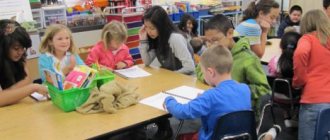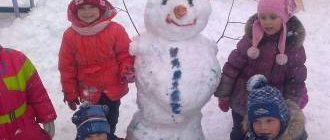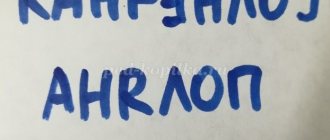Summary of an open lesson on FEMP according to the Federal State Educational Standard in the middle group on the topic: “In the country of mathematics”
count and indicate the quantity with a number. After all, a number is a sign of a number.”
But the king became even more sad, since he did not know the numbers and could not count! I propose to go to that country and help the king. Guys, let's help the king from
Star country? Now I’ll wave my magic wand and turn you into Astrologer’s assistants and we’ll go to the magical Star Country.
We close our eyes and spin around ourselves. “Crible-crable-boom...” (Music, turn on the lanterns) Spin around.
So we find ourselves in a magical, starry land, sit down at the starry tables. After all, now you young stargazers remember this.
Oh, guys, look, this is a portrait of the Tsar himself!
The king left his portrait, and he is watching you through a celestial telescope. He thinks: will they cope or not?..
1) Task “COUNT THE OBJECTS”
Q. Look: the king left not only his portrait, but also his cards, apparently those that he could not count.
Everyone has cards with numbers from 1 to 5 on the table. Count the items on the cards and indicate the number of items with a number
(children count the objects and indicate the desired number next to them).
- How many butterflies? Show number 5
- How many daisies? (and so on.)
Did you count everything correctly? Who didn't succeed?
How to count correctly?
(The children, together with the teacher, recite the algorithm: when recounting, you must not miss a single item and not count a single item twice).
I hear the king’s voice - he is very pleased with you. Well done!
2) Task “THE NUMBERS ARE CONFUSED”
(the teacher opens the curtain at the easel)
V.: A stellar hurricane apparently passed through this country. All the numbers are mixed up. Which number is out of place? (children's answer).
— What number comes before the number 3?
— What number comes after the number 1?
— What number is between the numbers 3 and 5?
Right. Well done, the king is very pleased with your answers.
3) GAME “STARS AND CLOUDS” V. (opens a magnetic board covered with stars and clouds).
Guys, look how many beautiful stars there are here. We are stargazers. Let's count how many stars? (4 stars here).
How many clouds? What more? How much more?
Let's put each star to sleep on a cloud.
Will there be enough clouds for all the stars? Why? What should be done?
(add another cloud).
The stars each rest on their own cloud. They probably have very beautiful colorful dreams.
4) PHYSICAL MINUTE (RELAX) “Star Song”
V. We will also have a little rest. Close your eyes and listen to the song. This is the princess's favorite lullaby.
(children lie down on the carpet with their toys - an audio recording of the song plays).
B. The alarm clock is ringing - it’s time to get up. And when we get up in the morning, what do we do? Exercise!
Features of an open lesson in mathematics in the middle group of preschool educational institutions
Open viewing of FEMP is an effective form of organizing the pedagogical process in kindergarten. Being one of the varieties of mathematical classes, this educational activity also solves educational, developmental and educational problems.
Educational objectives in the middle group are related to the content of the program. This is counting within five, comparing objects by size (by two characteristics at once), building a serial series, getting to know new geometric shapes (rectangle), developing orientation in space, expanding time concepts. In this case, an open mathematical lesson usually touches on several of these problems at once.
The developmental tasks of an open lesson are associated with the development of the intellectual sphere of a preschooler - the processes of thinking, attention, perseverance, and the development of correct speech. At the same time, the work is organized in such a way that the child acts as a leader, takes an active position, and reveals his abilities to the maximum.
Each open mathematical lesson necessarily carries an educational value. The teacher must select a topic that will contribute to the development of positive moral qualities in the preschooler, for example, love for his native land, the desire to treat plants and animals with care, etc.
When thinking through the content and structure of an open mathematical lesson in the middle group, the teacher should focus on the following important aspects.
- Meaningful. The open viewing should become a source of innovative experience for colleagues, touching on current problems of modern methods of preschool education, as well as child psychology. An innovative approach can be expressed in the very content of visual or handout material, or in some interesting methodological technique, the use of ICT, unusual organization of space, etc. After all, showing traditional mathematical activities will not contribute to the professional growth of the specialists present.
- Social. During an open lesson, the teacher creates a situation of success for preschoolers. To achieve this, praise, encouragement, and giving the child the right to make mistakes are actively used. The teacher demonstrates the strengths of children, revealing their thinking and creative abilities.
- Pragmatic. Open viewings of FEMP are an additional incentive for cognitive activity for middle group students. They enjoy playful activities (which always accompany such events) and attention from adults.
In an open lesson with children of the fifth year of life, the following is required:
- clear organization and planning of each stage of educational activity (unlike, for example, mathematical entertainment, where the script allows improvisation);
- a mandatory intriguing start to the lesson, which will become a motivating moment for children;
- coherence and logic of the plot (usually a journey is chosen, helping a fairy-tale hero, achieving a common useful goal);
- individual approach to children (the mental and somatic development of children is different, for example, someone else has speech problems);
- original visual aids that invited teachers will be able to produce and use in their practice;
- the teacher's friendly tone, appropriate facial expressions and gestures.
In order for the open event to be successful, all planned goals are realized, the topic is revealed, the teacher needs to prepare a detailed summary (which he coordinates with the preschool educational institution methodologist). Every action of the teacher is written down there: introductory remarks, assignments, questions, comments on them during the lesson, expected answers from children, etc.
As for organizational aspects, an open mathematical lesson in the middle group is conducted without “rehearsal” and has the usual duration for this age (20 minutes). Although children of the fifth year of life are no longer babies who can cry when they see strangers, you should still psychologically prepare the children for the event, and also inform their parents about it in advance.
Guests of open viewing are always provided with workstations behind preschoolers (so that they do not distract children from cognitive activity).
At the beginning of the lesson, the teacher draws the children’s attention to the adults present and offers to say hello to them - then the kids will not look at them during the activity.
Sometimes parents are also invited to open screenings - this is useful for strengthening family relationships and gives mothers and fathers a real idea of the level of knowledge and skills of their children. In the middle group, this can be practiced, but with caution, because there are always children who can get up and go to their mother during class. In this case, work with the rest of the children should continue as usual.
Methodology for conducting an open lesson in mathematics in the middle group (structure and forms of work)
Open viewing, being a type of educational activity, has a certain structure.
- Organization and motivational beginning of a lesson that stimulates preschoolers to cognitive activity (2–3 minutes).
- Main stage. Completing tasks that reinforce certain mathematical concepts, since during an open demonstration, an explanation of new material is usually not given.
- The final stage. Summing up (2-3 minutes): the teacher asks preschoolers to share their impressions of the event, talk about what they liked most and what caused difficulties.
During an open lesson, the teacher must alternate different forms of children's activities. This will enliven the course of the lesson and allow each child to reveal the abilities. The most appropriate would be a combination of group and subgroup types.
- Collective activities: frontal survey;
- didactic games;
- physical education minutes;
- finger games;
- outdoor games with mathematical content.
Individual work is an important part of an open mathematics lesson
Summary of GCD for FEMP in the middle group “Journey to the Land of Mathematics”
Category: Class notes Created: 11/21/2019
Teacher Anastasia Vadimovna Katueva
Goal: development of students’ mathematical abilities. Consolidating children's knowledge of quantitative and ordinal counting, the names of geometric shapes.
Tasks:
Educational:
- secure geometric shapes
- consolidate knowledge about numbers within 5;
- consolidate the ability to correlate numbers with the number of objects;
- improve counting skills
- strengthen children's ability to give complete answers
Educational:
- develop attention, logical thinking, speech, color perception, fine motor skills, perseverance, eye, memory.
Educational:
- cultivate the ability to listen to the opinions of others, listen carefully to the teacher’s questions and each other’s answers;
- develop the ability to work independently.
Integration of educational areas: “Cognitive development”, “Speech development”, “Physical development”, “Social and communicative”.
Educator:
Guys, this morning, when I came to work, I saw that there was a letter on my desk, but I decided not to open it and wait for you all to read it together.
Listen:
"Hello guys. The Queen of Mathematics is writing to you, I heard that you know numbers, geometric figures, and love to do mathematics. That's why I have prepared a gift for you - a surprise. But to get it, you need to travel and complete my tasks. If you are brave, determined, confident in your abilities, then hit the road. Bon Voyage".
Do you guys like math? Are you confident in your abilities and knowledge? Then let's go to the land of Mathematics!
Guys, do you like to travel? (children's answers)
And if you are very determined and brave, then I suggest you take a trip on an airplane carpet.
Educator: Oh, guys, our “airplane carpet” was gnawed by mice. We urgently need to fix the magic carpet. I have geometric shapes on my tray.
(Children take turns applying and identifying those “patches” that are suitable for repairing the carpet.)
Educator: What “patches” did you need to repair the rug?
Children: “Patches” in the shape of a square, rectangle, triangle, circle.
Educator: Our carpet is ready to fly.
Let's hold hands, sit on our airplane carpet and fly. Close your eyes. What do you imagine? (Sky clouds). What could be underneath us? (land, cars, houses, etc.)
Here is our carpet - the plane has arrived at the first station, it’s called the “Geometric Figures” station
"Geometric Figures" station.
Lay out the pattern according to the diagram (geometric shapes)
Educator: Well done! Now we will move on to the next station.
We arrived at the “number station”. Do you know the numbers? Can you count? We'll check this now.
- "Digital Station"
Correlate the figure with the number of items (stamps) according to Mate+ teaching materials
Physical exercise.
One - rise, stretch, (Stretched.) Two - bend, straighten, (Bent your backs, hands on the belt.) Three - clap your hands, three claps, (Clap your hands.) Three nods with your head. (Move your head.) At four - arms wider, (Arms to the sides.) Five - wave your arms, (Swing your arms.) And start counting again!
We are heading to the next station.
- "Bears on the Path"
(arrange the bears according to the diagram.) UMK Mate+
Educator: Well done guys! Look how many interesting tasks the Queen of Mathematics has prepared for us. Let us please her too and make some beads for her.
- “Beads for Queen Mathematics.
Repeat the pattern (chips) UMK Mate+
Educator: Our journey to the country of “Mathematics” has come to an end. Want to know what Queen Math has in store for you?
Let's go back to kindergarten! We sit down on our carpet. Let's fly!
— Tell me, what did you like most?
— What was the most difficult?
What was the easiest thing?
Where have we been and what have we done? (children’s answers, summing up the lesson)
This is where our journey ended. See you again!
- Back
- Forward







